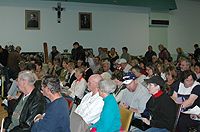|
Auction Tips
An Introduction to Auctions
 Ever thought of attending an auction -- but not done so? Lack of knowledge about the auction process often stops interested people from attending them.
Ever thought of attending an auction -- but not done so? Lack of knowledge about the auction process often stops interested people from attending them.
We're here to make sure you know what auctions are about, how they're conducted, and provide you with tips to make auctions a fun and rewarding experience!
You can start here for a little auction history and an outline on how auctions work - then use the links above for even more auction tips and info!
A Brief Overview
Auctions have been used for the buying & selling of property since Homeric times in Greece. Everything imaginable has been sold through auctions -- with artwork, antiques, stamps, coins and rare books being the most commonly known auction items.
But auctions are also used to sell agricultural products (loose-leaf tobacco is commonly sold at auction in the U.S.), used industrial machinery, secondhand household goods, motor vehicles, farms & ranches, buildings -- you name it, and some auctioneer has sold it!
The Auctioneer
The auctioneer is the agent of the seller. His job is to obtain the best price possible for an item. Auctioneers who are members of professional associations such as the Auctioneers Association of Canada are bound by a Code of Ethics that also spells out their duty to protect the public against fraud, misrepresentation or unethical practices with respect to items being presented at an auction.
A professional auctioneer is a marketing specialist, operating in a unique industry. He or she must have a working knowledge of the value of items being offered, know how to attract people most interested in those items, and be able to present the items in a manner that creates excitement and stimulates competition.
The Auctioneer's Chant
People are fascinated by the auctioneer's "rapid-fire" presentation in soliciting and accepting bids. This rythmic presentation is called the auctioneer's "chant".
The chant is primarily designed to create excitement and keep the sale of items moving steadily. And it's not as mysterious or confusing as some people believe!
The chant is simply a series of numbers (bids or requested bids) connected by "filler" words. The fillers give buyers time to think between bids.
A good chant is rythmic, with the speed of delivery adjusted to the experience of the crowd. Most important is clarity. Confused bidders don't buy, and don't return, so a good auctioneer ensures that the numbers -- the vital information in the chant -- are easily understood.
The Auction
At a traditional auction (an "absolute" auction), bids increase in succession until the final (i.e. highest) bid is accepted by the auctioneer. Sellers can protect their interests against exceptionally low bids with reserve bids, etc. (as defined in our Glossary).
Most auctions provide specific dates and/or times for viewing items being offered prior to the sale. Because most auction items are sold "as is", a careful inspection by potential buyers prior to the sale is important.
You must register at the auction for a bidder number if you intend to bid. Applicable rules (whether there are buyer's premiums to be paid on top of the bid amount, for example) are posted or included on the bid card, in catalogues or other material available. Ask questions if you are unsure of the policies of the auction house.
Once the sale starts the auctioneer solicits bids and acknowledges those recieved. Holding up your bid card, raising your hand, and even verbal acknowledgments are methods of signalling your next bid. And don't worry -- scratching an itch won't be misinterpreted as a bid!
If you want to drop out of the bidding process when the auctioneer turns to you for your next bid, simply shake your head firmly "no"
When it's over, be prepared to pay for your purchase immediately, as well as make arrangements for pickup or delivery (which will be at your expense).
Why Buy or Sell at Auctions?
A particular auction brings together a group of potential buyers interested in similar items. The interactive bidding process provides the gauge of what these various people feel the item is worth -- i.e., it sets the current market value of the item.
In the end, the seller gets the best price the market is willing to pay. The successful bidder gets the item at the price he or she is happy with. Unsuccessful bidders get insight into current values for similar items as well as enjoying a unique experience!.
So give auctions a try! They're different, they're fun -- and they just might have what you're looking for!
Source: Auctioneer's Association of Canada
|

